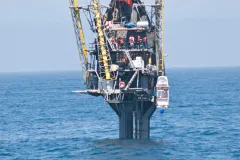FLIP: The FLoating Instrument Platform

You’re out to sea on a 355 foot platform, and suddenly one end begins to slowly tip underwater. Should there be a call for evacuation? Are you sinking?
Not if you’re on FLIP – the FLoating Instrument Platform – owned by the Office of Naval Research and operated by Scripps Institution of Oceanography. June 2012 marks the 50th anniversary of the launch of this unique measurement tool.
What is FLIP?
Launched on June 22, 1962, FLIP was developed by Scripps scientists Fred Fisher and Fred Spiess as an exceptionally stable platform for research related to a U.S. Navy submarine weapons program. The unique design of FLIP, resembling a long baseball bat, was inspired by thin floating devices known as “spar buoys.” In the early ’60s FLIP was considered an innovation in oceanographic design — and fifty years later it remains a one-of-a-kind wonder.
How does it work?
FLIP has no propulsion power, so its 355-foot frame is towed in the horizontal position to and from its scientific research locations. To begin the flipping process, FLIP’s operators direct water into several ballast tanks to begin a slow transition that lasts nearly 30 minutes. Once in the vertical position, 300 feet of FLIP is submerged. The remaining section features a command area, laboratory space, galley, bunks, and electric generators.
To transition back to the horizontal position, FLIP’s crew uses compressed air to expel water from the ballast tanks. Because its design accommodates riders in both horizontal and vertical positions, FLIP’s interior spaces often appear misleading and even bizarre, with doors mounted on the floor, portholes in the ceiling, objects mounted on swiveling trunions, and sinks and toilets mounted for both configurations.
How does the crew survive the flip of FLIP?
With ease. The whole crew heads up on deck while wearing lifejackets as FLIP slowly begins to dip underwater. The whole process takes about half an hour, and for the first 20 minutes it doesn’t feel like much is happening because the ballast tanks are filled so slowly. But the last five minutes are pretty exciting because, as FLIP goes vertical, the entire vessel spins in a circle 2-3 times. And after that rush, the horizontal world has been converted into a vertical world on the vessel.
Why is FLIP vital for science and society, even after 50 years?
- Military Support: Continuing a long history of working as a partner with the Navy, FLIP has served as a valuable tool supporting key projects with military and national security interests. In one recent example, Naval Research Laboratory scientists employed FLIP for oceanographic work using lasers.
- Science: FLIP provides a uniquely stable platform for research missions that include ocean acoustics, marine mammal studies, geophysics, meteorology and physical oceanography. Scripps oceanographer Walter Munk conducted groundbreaking research on FLIP’s first science mission, leading to an increased understanding of waves breaking across the ocean and improving surf forecasting for science and society.
- Education: Like other ships in Scripps’ fleet of research vessels, FLIP provides innovative access to science at sea for students. These “laboratories at sea” offer hands-on training for the next generation of scientists. In a recent project reaching young explorers, FLIP became the subject of a virtual field trip for 65,000 schoolchildren.

